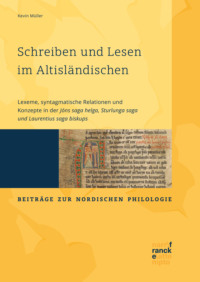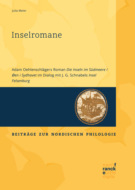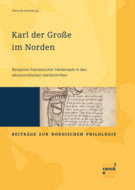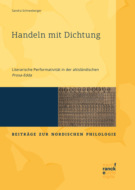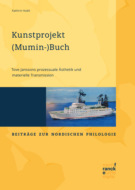Kitabı oku: «Schreiben und Lesen im Altisländischen», sayfa 33
Abstract & keywords
Writing and reading are two central aspects of medieval literacy. For the research of these aspects, both Latin and vernacular vocabularies played important roles, as they are reflective of differing writing and reading practices. In this way, the concepts WRITING and COMPOSING can be considered lexically distinct, as seen in the Latin in the distinction between dictare and scribere, and in Old Icelandic setja saman and, rita or skrifa (cf. e.g. Lönnroth 1964, Ludwig 2005, Müller 2018). Similar distinctions can also be found between reading aloud (legere/lesa), and silently (videre/sjá); or publicly (praelegere/lesa upp) and privately ([sibi] legere/lesa yfir). The same can also be observed to be the case for verbs of sight (videre/sjá) and hearing (audire/heyra) (cf. e.g. Glauser 2010, Green 1994, 2007, Müller 2018, Parkes 1999, Saenger 1999, Spurkland 2000), and in the reproduction of written texts, one must also distinguish between reading out (lesa) and recounting (bera fram) (e.g. Spurkland 2000). Furthermore, the medieval Scandinavian scripts and the connected pathways of interpretation literacy and runacy, which can be differentiated on the basis of form, materiality, and language, also have an effect on vocabulary (e.g. Spurkland 2004). Namely, lexical differences between runic writing (rísta) and reading (ráða) and those verbs used to describe the same processes associated with the Latin script (rita/skrifa and lesa respectively). Here, the delineation of the verbs lesa, sjá, bera fram, and ráða makes it clear that in previous research only isolated aspects and dichotomies were distinguished, and that these are strongly marked by studies in the change from orality to literacy. This narrow viewpoint has been increasingly broadened in the most recent studies in mediality, which has allowed for new insights into literate practices (e.g. Glauser 2010, Glauser/Heslop 2018, Lutz et al. 2010, Schnyder 2006, Teuscher 2007). Besides orality and literacy, further aspects have gained attention, such as the body, memory, visuality, materiality, authority, rhetoric, voice and language. Mediality research has however only marginally included studies in vocabulary. For this reason, the question as to how such new aspects are reflected in it, or indeed to what degree they can be considered as belonging to the concepts of reading and writing. The dichotomies discussed here are products of non-linguistic or structuralistically influenced semantic analyses, which were concerned with word-pairs and a binary schema. A further reason is offered by those analyses, which were limited to of producing fragmentary semantic impressions, due to their reliance on single text-passages. My work on the Sturlunga saga offered the insight that more extensive texts also meet their limits (vgl. Müller 2018), such that the meaning of single lexemes cannot be reasoned without further doubt. In this analysis the question also arose, as to what sort of framework connects a lexeme and its context, as meaning is dependent on its context. A study of vocabulary requires therefore a broader corpus as well as a theoretical approach, which incorporates the relationship between lexeme and context. Previous research shows that a more comprehensive linguistic analysis of the vocabulary would lead to a clearer image of the medieval literacy-concepts, without reliance on the dichotomies as mentioned above, nor over-interpretation.
A theoretical approach, which would allow for the incorporation of context, and which is particularly suited to semantic studies is frame-semantics. In the presented dissertation, there were two frame-semantic models of importance: that of Charles J. Fillmore and that of Laurence W. Barsalou. Fillmore (1982/2006) builds upon the syntagmatic relationships by means of comparing syntactic valency and its supplementary information with semantic valency, that is, the frame with its roles. Under the term frame, Fillmore understands a system of concepts, which are recognised as a whole, for a single concept to be comprehensible. In the sentence I’m writing an abstract, only two roles occur: the WRITER as subject and the TEXT as the direct object. The concept of WRITING includes, for example, concepts such as LANGUAGE and WRITING TOOL. These roles in the concept WRITING remain slots in the sentence above, but can be filled, as in the sentence I’m writing an abstract in English on the keyboard. In understanding the process, the sociocultural background plays a central role. Writing has seen enormous technical changes in the past century, from the pen, by way of the typewriter, to the computer. These carry with them effects on the concept. Although Fillmore’s concept is able to draw a connection between syntactic and semantic levels, the meaning can however not be closer described on this basis. For the analysis of such relationships, the frame theory of the cognitive-psychologist Laurence W. Barsalou (1992a, 1992b) is better suited, as it not only depends on syntactic relations, but rather cognition. The frame structures the concept, formed by descriptive information, which are representative of a cognitive category, corresponding to the intension or meaning. The structure consists of attributes, values, and diverse relations. The attributes correspond vastly to the roles as described by Fillmore. Barsalou’s model goes deeper, however, as the attributes are designated values. This is here demonstrated with the concept writing: The attribute of TEXT has the values such as abstract, saga, letter; LANGUAGE, the values of German, English, Old Icelandic; WRITING TOOL, the values of pen, typewriter, computer. An important form of relation in Barsalou’s model are constraints, which are subordinated to attributes and values. The linguistic competence of the writer or genre-specific restrictions limit the language, genre, writing tool etc. For stereotypical concepts, default values can be expected. Barsalou manages with help of his model to describe concepts excellently. For the application on historical language, however, this model faces the problem that it assumes that the concepts are known. This gap can be bridged by Fillmore’s model in building upon the syntagmatic relationships, which are reflective of the structure of the concept. Thus, in order to analyse the vocabulary of writing and reading in Old Icelandic, the lexeme and its syntagmatic relationships form the basis.
As the attributes of frames are often slots, the research must rely on the most comprehensive digital corpus available, for which there is no such suitable corpus in Old Icelandic. On one hand, most corpora are based on non-critical editions, and on the other hand, core sources from the 12th to 14th century such as the contemporary and bishops’ sagas are missing. For this reason, it is necessary, to read the texts and collect extracts relevant to the concepts of reading and writing. This laborious sampling limits the opportunity for a large corpus, making the need to collect particularly relevant passages even more pertinent. Thus, three texts were found to be particularly relevant: Jóns saga biskups, Sturlunga saga and Laurentius saga biskups. This choice was based on the following criteria: They contain many records of reading and writing, they are written in Old Icelandic, take place predominantly in Iceland, where they were also produced, and they are mostly transmitted in medieval manuscripts. There are critical editions for all three texts.
Writing and reading were analysed with frame semantics in the presented dissertation on the basis of the three corpus texts. Both analysis parts (II and III), which follow the same structure, follow the orientation part (I), which has been summarised above, including an introductory chapter (1) and chapters on frame semantics (2), and the corpus (3). Section II deals with writing-concept, and III with the reading-concept. The introductory chapter builds upon the previous research about the respective vocabularies of the following chapters, as well as their relationships, concepts and possible frame-attributes. Subsequently, the individual quotations relevant for the study are researched on the basis of their syntagmatic relationships, and these in turn assigned to the possible frame-attributes. The quotations are ordered both according to text and lexeme. The larger passages studied are where necessary further studied on the basis of valency and collocations. The results of the individual lexemes and texts are summarised at the end of the respective chapter. Part IV consists of the conclusions of the study. From the conclusions, the following results and insights can be summarised.
The verbs in part II can be summarised into the concepts of WRITING including rísta, rita/ríta, skrásetja, skrifa; and COMPOSING, including setja saman and dikta. Decisive for this partition are the attributes discussed here, beginning with rita/ríta, which is only minimally differentiated from skrifa which shows a large number of attributes, of which the thematic role accompanies in brackets: SCRIBE (Agent), SCRIPT (Theme, í e-t/-u), CONTENTS (Theme, um e-t), PART (Theme), TEXT BEARER (á e-t/-u), LANGUAGE (Theme, á e-t/-u), CLIENT (Dative, Causer), BODY-PART (með e-u), WRITING MATERIAL, WRITING TOOL (með e-u), WRITING SYSTEM (Dative), WRITTEN FORM (Adverb of manner), SOURCE (eptir e-u), MATERIAL (af e-u) and PURPOSE (til e-s). Different aspects of mediality research are reflected in these attributes and thus part of the literacy-concept. The concepts of literacy and runacy only show differences in the values of the attributes of WRITING SYSTEM, WRITING MATERIAL, WRITING TOOL and TEXT BEARER.
Rita/ríta and skrifa do not only evoke this frame, but also one of correspondence with a completely different set of attributes: SENDER (Agent), MESSAGE (Theme), MESSENGER (með e-m), ADDRESSEE (til e-s) and AFFAIR (um e-t). This second frame must be considered at each instance of the lexeme, as only individual details and complements are indicative of it. Previous research only scarcely considered this significant semantic difference.
The difference between WRITING and COMPOSING can be grasped on the basis of a number of attributes. Setja saman is distinguished with the attributes COMPOSER (Agent), TEXT (Theme) and RHETORIC (adverb of manner). Here, the attribute RHETORIC is considered to include elocutio, inventio, and dispositio, whereas dikta includes only the attribute ELOCUTIO. The attributes BODY-PART, TEXT BEARER, WRITING MATERIAL/WRITING-TOOL, WRITTEN FORM und WRITING SYSTEM are missing for these verbs. This absence of corporeal, material and visual attributes indicates a composition process lexically differentiated from writing. The attributes LANGUAGE, SOURCE, MATERIAL, CONTENTS und CLIENT with the same complements indicate however that the concepts do overlap in a number of ways. Doubled forms such as setja saman ok rita additionally confirm that the two processes are undertaken by the same individual. Here, of exceptional interest is the hypernym gera bók or bréf, which includes both aforementioned processes. The verb directs the focus on the TEXT as the theme and the CLIENT as agent, likewise involved in the text’s production. The concepts of WRITING and COMPOSING can be lexically distinguished but also linked intrinsically.
In the reading vocabulary, analysed in part III, the verb lesa takes the position as a hypernym and thus has access to the broadest frame in this category, consisting of the attributes READER (Agent), TEXT (Theme), WRITTEN FORM or WRITING-SYSTEM (Theme), VOICE (Adverb of manner), CLIENT (Causer), LISTENER (fyrir/yfir e-m, Dative), TEXT BEARER (af e-u), PURPOSE (til e-s), SETTING (Locative adverbial), and TIME (Temporal adverbial). For research in orality and literacy, the attribute VOICE is of particular interest. Its values do not only include aspects of audibility, but also those of aesthetics, rhetoric and correctness. This is the case across the dichotomy of both public and private contexts, which is subject to the attribute of SETTING, the values of which are very diverse, such as devotion, study, mass, edification or presentation of letters. The values of this attribute have an influence on VOICE, as the quality of the voice as a text is read differently in mass than it is in private devotion. In consideration of this, there are a number of constraints between the attributes TEXT, VOICE, and SETTING. The setting also offers evidence regarding mediality, as a text is read aloud from a writing-surface within a specific setting by means of voice to an audience, who can see and hear it. The respective reading practices can be reasoned from the values of all of the attributes. The setting may however not be equated with the reading practice itself. Reading is primarily considered to be the deciphering and perhaps the recitation; The setting is the culmination of what happens peripherally, into which the reading practice itself is inserted.
The hypernyms can be delineated into different attributes and values. Lesa upp is found uniquely in juristic and public settings and thus the value of the attribute VOICE is too. Lesa yfir is different in this way, as it is used in settings, in which the reading is not audible. It also includes the attribute ACCURACY which differentiates it from verba videndi sjá and líta. Lesa yfir represents an exact reading, the verba videndi on the other hand for a less-exact regard for the text bearer. This diversity of attributes and values demonstrates that verbs cannot be reduced to binary features such as [±AUDIBLE] and [±PUBLIC]. The comparison of bera fram and lesa does not allow adequate consideration for the polysemy of bera fram, which includes pronunciation, exhibition, demonstration, and presentation, but which does not necessarily exclude reading out.
The present corpus and the use of frame semantics allowed the systematic analysis of the reading and writing concepts. The often broad frames with diverse attributes and values demonstrate, that medieval literacy should not be reduced to dichotomies. The frame allows furthermore the structured delineation of concepts, whereby paradigmatic relationships and semantic shifts can be traced. Owing to this it was also possible to integrate or exclude diverse aspects of mediality in the concepts. This permits further links to be made beyond the areas of literacy and mediality. The analysis of the concepts on the basis of syntagmatic relations as a methodology can be applied to further lexemes and languages, where it will allow further insights in other areas of research.
Translated by Michael Redmond.
Keywords
Old Icelandic, historical linguistics, literacy, frame semantics, medial change, Jóns saga helga, Sturlunga saga, Laurentius saga biskups
Abkürzungen
| AcI | accusativus cum infinitivo |
| Adv. | Adverb |
| aengl. | altenglisch |
| afrz. | altfranzösisch |
| ahd. | althochdeutsch |
| Akk. | Akkusativ |
| anord. | altnordisch |
| as. | altsächsisch |
| Dat. | Dativ |
| e-n | einhvern ‚jemanden (Akk. Sg. m.)‘ |
| e-m | einhverjum ‚jemandem (Dat. Sg. m.)‘ |
| e-s | einhvers ‚jemandes, einer Sache (Gen. Sg. m./n.)‘ |
| e-t | eitthvat ‚etwas (Nom./Akk. Sg. n.)‘ |
| e-u | einhverju ‚etwas (Dat. Sg. n.)‘ |
| nengl. | neuenglisch |
| nnorw. | neunorwegisch |
| f. | feminin |
| got. | gotisch |
| Ind. | Indikativ |
| Inf. | Infinitiv |
| jdm. | jemandem |
| jdn. | jemanden |
| jds. | jemandes |
| Kap. | Kapitel |
| Konj. | Konjunktiv |
| lat. | lateinisch |
| m. | maskulin |
| mengl. | mittelenglisch |
| mhd. | mittelhochdeutsch |
| mnd. | mittelniederdeutsch |
| n. | Neutrum |
| nisl. | neuisländisch |
| Nom. | Nominativ |
| nnorw. | neunorwegisch |
| Part. | Partizip |
| Präs. | Präsens |
| Prät. | Präteritum |
| Pl. | Plural |
| Sg. | Singular |
| urgerm. | urgermanisch |
| urnord. | urnordisch |
Literatur
Baetke, Walter (1967). Geschichten vom Sturlungengeschlecht (= Thule 24). Neuausg. mit Nachwort v. Rolf Heller. Darmstadt: Wissenschaftliche Buchgesellschaft.
Baetke, Walter (2002). Wörterbuch zur altnordischen Prosaliteratur (= Sizungsberichte der Sächsischen Akademie der Wissenschaften zu Leipzig. Philologisch-historische Klasse 111, 1–2). 6. unver. Aufl. (1. Aufl. 1965/68). Berlin: Akademie Verlag.
Barsalou, Lawrence (1992a). „Frames, Concepts, and Conceptual Fields“. In: Lehrer, Adrienne/Kittay, Eva Feder (Hg.). Frames, Fields and Contrasts: New Essays in Semantic and Lexical Organization. Hillsdale (N.J.): Lawrence Erlbaum Associates, S. 21–74.
Barsalou, Lawrence (1992b). Cognitive Psychology. An Overview for Cognitive Scientists. New Jersey: Lawrence Erlbaum Associates.
Benediktsson, Hreinn (Hg.) (1972). The First Grammatical Treatise (= University of Iceland, Publications in Linguistics 1). Reykjavík: Institute of Nordic Linguistics.
Benediktsson, Jakob (Hg.) (1944). Veraldar saga (= Samfund til Udgivelse af gammel nordisk Litteratur 61). København: Bianco Lunos Bogtrykkeri A/S.
Benediktsson, Jakob (1993). „Íslendingabók“. In: Pulsiano, Phillip (Hg.). Medieval Scandinavia. An Encyclopedia. New York [etc.]: Garland, S. 332f.
Bibire, Paul (1993a). „Páls saga biskups“. In: Pulsiano, Phillip (Hg.). Medieval Scandinavia. An Encyclopedia. New York [etc.]: Garland, S. 496.
Bibire, Paul (1993b). „Þorláks saga helga“. In: Pulsiano, Phillip (Hg.). Medieval Scandinavia. An Encyclopedia. New York [etc.]: Garland, S. 671.
Bjarnarson, Þorvaldur (Hg.) (1878). Leifar fornra kristinna frœða íslenzkra. Kaupmannahöfn: Hagerup.
Björnsson, Árni (Hg.) (1969). Laurentius saga biskups (= Rit Handritastofnunar Íslands 3). Reykjavík: Handritastofnun Íslands.
Björnsson, Árni (1993). „Laurentius saga biskups“. In: Pulsiano, Phillip (Hg.). Medieval Scandinavia. An Encyclopedia. New York [etc.]: Garland, S. 381f.
Bjorvand, Harald/Lindeman, Fredrik Otto (2007). Våre arveord. Etymologisk ordbok. Revidert og utvidet utgave. Oslo: Novus Forlag.
Blöndal Magnússon, Ásgeir (2008). Íslensk orðsifjabók. 3. prentun. [Reykjavík]: Orðabók Háskólans.
Bragason, Úlfar (2005). „Sagas of Contemporary History (Sturlunga saga). Texts and Research“. In: McTurk, Rory (Hg.). Companion to Old Norse-Icelandic literature and culture. Oxford: Blackwell, S. 427–446.
Braun, Christian (2016). „Verbvalenz im kognitiven Rahmen. Zum Wechselspiel zwischen syntaktischen und textlinguistisch-kognitiven Parametern innerhalb ausgewählter althochdeutscher Gebete (Otlohs Gebet, Augsburger Gebet, Freisinger Benediktionen)“. In: Greule, Albrecht/Korhonen, Jarmo (Hg.). Historisches syntaktisches Verbwörterbuch. Valenz- und konstruktionsgrammatische Beiträge (= Finnische Beiträge zur Germanistik 34). Frankfurt a.M.: Peter Lang, S. 97–109.
Busse, Dietrich (2009). Semantik. Paderborn: Wilhelm Fink.
Cahill, Peter (Hg.) (1983). Duggals Leiðsla (= Rit 25). With an English translation. Reykjavík: Stofnun Árna Magnússonar.
Cederschiöld, Gustaf (Hg.) (1879). Clarus saga. Clari fabella. Lund: Berling.
Cook, Robert/Tveitane, Mattias (Hg.) (1979). Strengleikar. An Old Norse Translation of Twenty-one Old French Lais (= Norrøne tekster 3). Oslo: Norsk historisk kjeldeskrift-institutt.
Curschmann, Michael (1984). „Hören – Lesen – Sehen. Buch und Schriftlichkeit im Selbstverständnis der volkssprachlichen literarischen Kultur Deutschlands um 1200“. In: Beiträge zur Geschichte der deutschen Sprache und Literatur 106, S. 218–257.
Dipl. Isl. = Hið íslenzka bókmenntafélag (Hg.) (1857–1952). Diplomatarium Islandicum. 16 Bde. Reykjavík: Félagsprentsmiðja.
Dipl. Norv. = Magerøy, Hallvard/Næshagen, Ferdinand Linthoe (Hg.) (1847–1995). Diplomatarium norvegicum. Oldbreve til kundskab om Norges indre og ydre forhold, sprog, slægter, sæder, lovgivning och rettergang i middelalderen. 22 Bde. Oslo: Norsk-Historisk Kjeldeskrift-Institut.
Düwel, Klaus (2007). Runenkunde. 4. überarb. und akt. Aufl. Stuttgart/Weimar: Metzler.
Egilsdóttir, Ásdís (2003). „Biskupasögur og helgar ævisögur“. In: Steingrímsson, Sigurgeir et al. (Hg.). Biskupa sögur I (= Íslenzk fornrit 15, 1). Reykjavík: Hið íslenzka fornritafélag, S. VIII–XXX.
Einarsson, Bjarni (Hg.) (2001). Egils saga Skallagrímssonar. Bd. 1. A-redaktionen (= Editiones Arnamagnæanæ, Series A, 19). København: C. A. Reitzels Forlag.
Faarlund, Jan Terje (2004). The syntax of Old Norse. New York: Oxford University Press.
Fillmore, Charles (1977). „Scenes-and-Frames Semantics“. In: Zampolli, Antonio (Hg.). Linguistic Structures Processing. Third International Summer School on Computational and Mathematical Linguistics, Pisa, August–September 1974 (= Fundamental Studies in Computer Science 5). Amsterdam a. o.: North Holland, S. 55–81.
Fillmore, Charles (1982/2006). „Frame Semantics“. In: Geeraerts, Dirk (Hg.). Cognitive Linguistics. Basic Readings. Berlin: Mouton de Gruyter, S. 373–400.
Fillmore, Charles/Atkins, Beryl (1992). „Toward a Frame-Based Lexicon: The Semantics of RISK and its Neighbors“. In: Lehrer, Adrienne/Kittay, Eva Feder (Hg.). Frames, Fields and Contrasts: New Essays in Semantic and Lexical Organization. Hillsdale (N.J.): Lawrence Erlbaum Associates, S. 75–102.
Fillmore, Charles/Atkins, Beryl (2000). „Describing Polysemy: The Case of ‚Crawl‘“. In: Ravin, Yael/Leacock, Claudia (Hg.). Polysemy. Theoretical and Computational Approaches. Oxford: Oxford University Press, S. 91–110.
Foote, Peter (1993). „Jóns saga ins helga“. In: Pulsiano, Phillip (Hg.). Medieval Scandinavia. An Encyclopedia. New York [etc.]: Garland, S. 345.
Foote, Peter (Hg.) (2003a). Jóns saga Hólabyskups ens helga (= Editiones Arnamagnæanæ, Series A, 14). København: C. A. Reitzels Forlag.
Foote, Peter (2003b). „Jóns saga helga.“ In: Steingrímsson, Sigurgeir et al. (Hg.) (2003): Biskupa sögur I (= Íslenzk fornrit 15, 1). Reykjavík: Hið íslenzka fornritafélag, S. CCXIII–CCCXXI.
Fritz, Gerd (2005). Einführung in die historische Semantik (= Germanistische Arbeitshefte 42). Tübingen: Niemeyer.
Fritz, Gerd (2006). Historische Semantik. 2. akt. Aufl. Stuttgart/Weimar: Metzler.
Fritzner, Johan (1886–1896). Ordbog over det gamle norske Sprog. Omarbeidet, forøget og forbedret Udgave. 3 Bde. Kristiania: Den norske Forlagsforening.
Fritzner, Johan/Hødnebø, Finn (1972). Ordbog over det gamle norske Sprog. Bd. 4. Rettelser og tillegg. Oslo/Bergen/Tromsø: Universitetsforlaget.
Gärtner, Kurt (2006). „tihten / dichten. Zur Geschichte einer Wortfamilie im älteren Deutsch“. In: Dicke, Gerd et al. (Hg.). Im Wortfeld des Textes. Worthistorische Beiträge zu den Bezeichnungen von Rede und Schrift im Mittelalter (= Trends in Medieval Philology 10). Berlin/New York: de Gruyter, S. 67–81.
Geeraerts, Dirk (2010). Theories of Lexical Semantics. Oxford: University Press.
Georges, Karl Ernst (1998). Ausführliches lateinisch-deutsches Handwörterbuch. Unveränderter Nachdruck der 8. verb. und verm. Aufl. 2 Bde. (Reprint der Ausgabe Hannover 1913/18). Darmstadt: Wissenschaftliche Buchgesellschaft.
Gering, Hugo (Hg.) (1882). Islendzk Æventyri. Isländische Legenden Novellen und Märchen. Bd. 1. Halle a.S.: Verlag der Buchhandlung des Waisenhauses.
Gjerløw, Lilli (1965). „Litani“. In: Brøndsted, Johannes et al. (Hg.). Kulturhistorisk leksikon for nordisk middelalder. Fra vikingetid til reformationstid. Bd. 10. København: Rosenkilde og Bagger, Sp. 606f.
Gjerløw, Lilli (1966). „Maria-antifon“. In: Brøndsted, Johannes et al. (Hg.). Kulturhistorisk leksikon for nordisk middelalder. Fra vikingetid til reformationstid. Bd. 11. København: Rosenkilde og Bagger, Sp. 276–278.
Glauser, Jürg (2010). „Staging the Text. On the Development of a Consciousness of Writing in the Norwegian and Icelandic literature of the Middle Ages“. In: Mundal, Else/Rankovic, Slavica (Hg.). Along the Oral-Written Continuum. Types of texts, relations and their implications. Turnhout: Brepols, S. 311–334.
Glauser, Jürg/Heslop, Kate (2018). „Introduction: Medial perspectives on textual culture in the Icelandic Middle Ages“. In: Glauser, Jürg/Heslop, Kate (Hg.). RE:Writing. Medial Perspectives in Late Medieval Icelandic Textual Culture (Medienwandel – Medienwechsel – Medienwissen 27). Zürich: Chronos, S. 9–59.
Glessgen, Martin-Dietrich (2011). „Le statut épistémologique du lexeme.“ In: Revue de linguistique Romane 75, S. 391–468.
Grape, Anders et al. (Hg.) (1977). Snorre Sturlasons Edda. Uppsala-Handskriften DG 11. Bd. 2. Transkriberad text och Paleografisk kommentar. Uppsala: Almqvist & Wiksell.
Green, Dennis Howard (1994). Medieval Listening and Reading. The primary reception of German Literature 800–1300. Cambridge: Cambridge University Press.
Green, Dennis Howard (2007). Women readers in the Middle Ages. Cambridge: Cambridge University Press.
Grímsdóttir, Guðrún Ása (Hg.) (1998). Biskupa sögur III. Árna saga biskups. Lárentius saga biskups. Söguþáttur Jóns Halldórssonar biskups. Biskupa ættir (= Íslensk fornrit 17). Reykjavík: Hið íslenzka fornritafélag.
Grímsdóttir, Guðrún Ása (2003). „Úr sögu kristni og kirkju í norðurálfu 1000–1400“. In: Steingrímsson, Sigurgeir et al. (Hg.): Biskupa sögur I (= Íslenzk fornrit 15). Reykjavík: Hið íslenzka fornritafélag, S. XXX–LIV.
Häny, Arthur (2011): Snorri Sturluson. Prosa-Edda. Altisländische Göttergeschichten. Aus dem Altisländischen übersetzt, mit Anmerkungen und einem Nachwort von Arthur Häny. Zürich: Manesse.
Hauksson, Þorleifur (Hg.) (1972). Árna saga biskups (= Rit 2). Reykjavík: Stofnun Árna Magnússonar á Íslandi.
Häussling, Angelus (1997). „Stundengebet“. In: Angermann, Norbert et al. (Hg.). Lexikon des Mittelalters. Bd. 8. München: Artemis, Sp. 260–65.
Halldórsson, Ólafur (Hg.) (1958–2000). Óláfs saga Tryggvasonar en mesta (= Editiones Arnamagnæanæ, Series A, 1–3). 3 Bde. København: C. A. Reitzels Forlag.
Halldórsson, Ólafur (Hg.) (1970). Jónsbók og Réttarbœtr. Genoptrykt efter udgaven 1904 med en efterskrift af Gunnar Thoroddsen. [Odense]: Odense Universitetsforlag.
Haraldsdóttir, Kolbrún (1998). „Der Historiker Snorri: Autor oder Kompilator?“. In: Fix, Hans (Hg.). Snorri Sturluson. Beiträge zu Werk und Rezeption. Berlin, New York: de Gruyter, S. 97–108.
Helander, Sven (1957). „Communio“. In: Brøndsted, Johannes et al. (Hg.). Kulturhistorisk leksikon for nordisk middelalder. Fra vikingetid til reformationstid. Bd. 2. København: Rosenkilde og Bagger, Sp. 583.
Helgadóttir, Þorbjörg (Hg.) (2010). Rómverja saga (= Rit 77). 2 Bde. Reykjavík: Stofnun Árna Magnússonar í íslenskum fræðum.
Helgason, Jón (Hg.) (1938). Byskupa sǫgur. Udgivet af det kongelige nordiske oldskriftselskab. 1. hefte. København: Ejnar Munksgaard.
Helgason, Jón (Hg.) (1978). Byskupa sǫgur (= Editiones Arnamagnæanæ, Series A, 13). 2. hæfte. København: Munksgaard.
Heringer, Hans Jürgen (1993). „Empirie in der Sprachgeschichtsschreibung“. In: Heringer, Hans Jürgen/Stötzel, Georg (Hg.). Sprachgeschichte und Sprachkritik. Festschrift für Peter von Polenz zum 65. Geburtstag. Berlin/New York: de Gruyter, S. 52–68.
